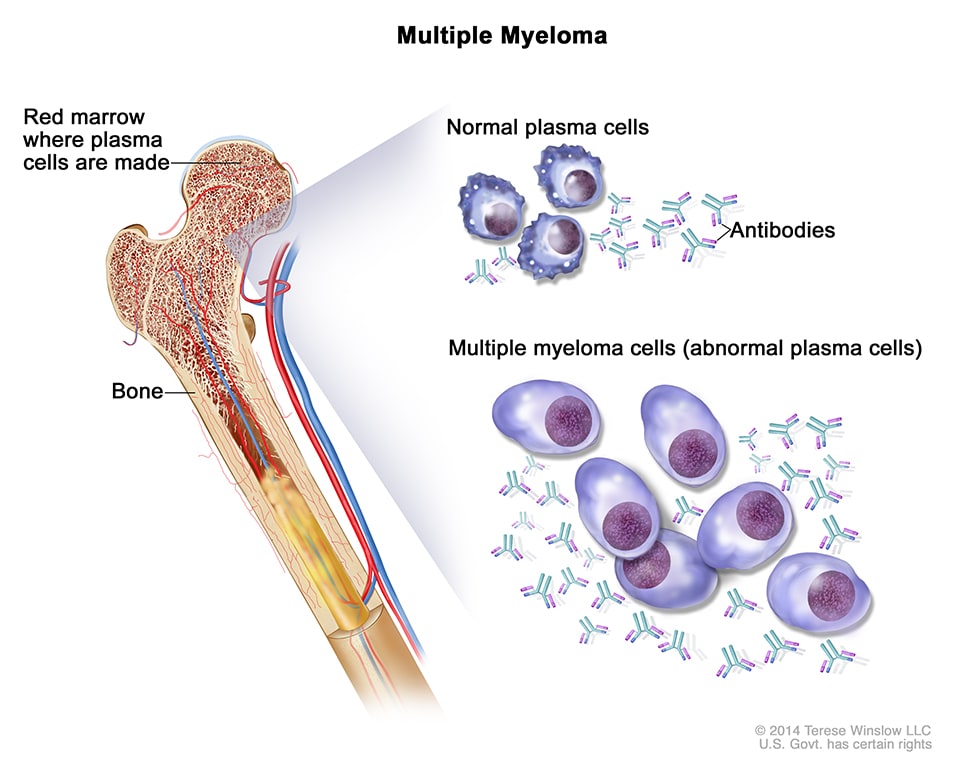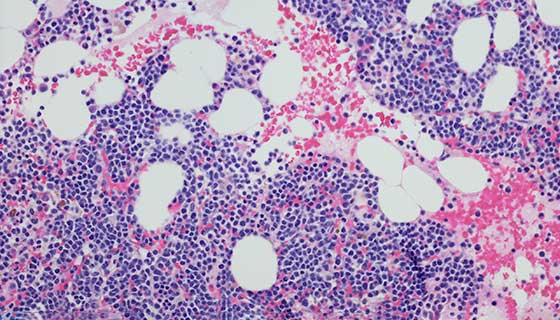Multiple Myeloma Stages are rare cancer that starts in plasma cells, which are part of the immune system. Plasma cells produce antibodies that protect the body from infections and other diseases. The disease is most often diagnosed in people over the age of 60.
Multiple myeloma is cancer that affects the plasma cells. This type of cancer can be found in both men and women. It is most often found in people over 50 years old.
Multiple myeloma is a cancerous plasma cell malignancy that primarily afflicts the bone marrow. A cancerous tumor grows and spreads through the body.
Multiple myeloma is a cancer of the blood cells often confused with other blood cancers, such as lymphoma.

Because of its unique nature, multiple myeloma is a particularly difficult cancer to diagnose and treat. In this blog post, we will discuss the stages of multiple myeloma and how to diagnose and treat this type of cancer.
Multiple Myeloma
Every year, new treatments, protocols, and new drugs are introduced into the market. In this blog, I will review the latest research, news, and treatment options for patients with Multiple Myeloma.
Multiple Myeloma (MM) is a cancer of the plasma cells. It is one of the most aggressive types of blood cancer and has the highest mortality rate.
Although there are new treatments, the prognosis for MM remains poor. However, with early diagnosis and treatment, patients can expect to live well into their 70’s.
Here are many types of cancer, each with its characteristics and stages of progression. If you’re like me, you may be interested in learning about the different types of cancer.
Cancer is an illness that affects one out of every two people in the United States. It can be caused by environmental factors such as smoking or excessive radiation exposure, or it can develop due to genetic factors.
Stage of Multiple Myeloma
Multiple Myeloma is cancer that affects the blood cells. Cancer spreads to the bones, causing pain and weakness. There are several stages of multiple myeloma and a treatment plan for each step. This article describes the stages of multiple myeloma, its symptoms, and treatment options.
Multiple myeloma is cancer that affects the blood cells. Cancer spreads to the bones, causing pain and weakness. There are several stages of multiple myeloma and a treatment plan for each step.
The final stage of multiple myeloma is characterized by cancer cells multiplying uncontrollably. This leads to bone destruction and sometimes spinal cord compression.
Here’s the truth, you can’t diagnose multiple myeloma just by looking at blood test results. There are so many different types of cancer, and sometimes a person has one kind and another simultaneously.
Talking to your doctor is the best way to know where you stand. You can also ask a lot of questions on this site.
What You Need to Know
Multiple myeloma (MM) is a blood cancer characterized by the development of monoclonal plasma cells in the bone marrow. The condition affects both men and women, although it is slightly more common in men.
There are four main stages of MM, each with a different set of symptoms. Unfortunately, each step is also associated with other treatment options.
Stage 1: Asymptomatic (AA)
This stage is the first stage of multiple myeloma. It is characterized by the absence of signs or symptoms related to the disease. Patients with this stage often have normal blood counts and normal bone marrow.
Stage 2: Mildly symptomatic (MA)
Patients with stage 2 MM experience mild bone pain, fatigue, and low-grade fever. They may also have anemia, weight loss, and night sweats.
Stage 3: Severely symptomatic (MS)
Patients with stage 3 MM have severe bone pain, weakness, and fatigue. They may also experience other symptoms, such as shortness of breath, back pain, and nausea.
Treatment
As we’ve learned in the previous sections, multiple myeloma is a cancer of plasma cells. There are five stages of the disease, and at each stage, there is an opportunity for treatment.
The first is the asymptomatic stage, lasting for years without symptoms. This is often when the patient receives a diagnosis of multiple myeloma.
Multiple myeloma is a cancer of the bone marrow. When the bone marrow produces too many white blood cells, myeloma develops.
As a result, it may cause bone fractures, kidney problems, anemia, and low blood counts. There are also other complications.

Multiple myeloma can happen at any age, but it’s most common in people over 50. The average patient is between 60 and 70 years old.
Multiple myeloma is rare, accounting for only 1% of all cancer cases. But it’s more common in men than women.
There are two types of multiple myeloma:
Plasma Cell Myeloma – This type is more common in women. It makes white blood cells, or plasma cells, grow uncontrollably.
Castleman’s Disease – This type of myeloma affects young adults. It’s often called the “plasma cell tumor.” It has similar symptoms to other cancers.
How to Diagnose
Multiple Myeloma is a type of cancer that affects white blood cells. These cells are involved in fighting infections and destroying pathogens. When multiple myeloma grows too large, it can damage bones, the liver, and kidneys.
Multiple myeloma is a cancer of the plasma cells. The disease has various stages, and the first stage involves a small number of plasma cells that cause anemia, pain, and bone destruction. The second stage involves more plasma cells, which cause bone destruction, kidney failure, and an increased risk of infections.
The third stage of multiple myeloma is characterized by excessive numbers of plasma cells crowding other blood cells. These plasma cells cause inflammation and interfere with the immune system.
The fourth stage of multiple myeloma is the terminal stage. Patients may die within months from complications of the disease or infections.
Frequently Asked Questions (FAQs)
Q: How long did developing the knowledge and skills you need to start your own business take?
A: I started my own business in April 2014.
Q: What advice would you give someone who wants to start their own business?
A: Start with a simple goal, like getting ten clients. If you are unsure if you can do it, you must start somewhere.
Q: Is there anything else you’d like to share?
A: Yes! I am proud to say that I am in remission from Multiple Myeloma. It has made me a better person, wife, mom, and daughter. I now have an even bigger passion for life.
Q: How does someone know they are in Multiple Myeloma Stages 3 or 4?
A: A person can be in multiple myeloma stages 3 or 4. It depends on their symptoms. If someone is experiencing weakness, pain, fatigue, weight loss, fever, night sweats, bruising, loss of appetite, or infection, they could be stage 3 or 4. A person can also be in multiple myeloma stage 3 or 4 if they have high white blood cells (WBCs) and low red blood cells (RBCs). In multiple myeloma stage 3, the WBC count is greater than 11,000 per cubic millimeter, and the RBC count is less than 3.2 million per cubic millimeter. In multiple myeloma stage 4, the WBC count is greater than 25,000 per cubic millimeter, and the RBC count is less than 2 million per cubic millimeter
Q: How did you first hear about Multiple Myeloma Stages?
A: I was diagnosed with multiple myeloma in 2006 and heard about Multiple Myeloma Stages through the myeloma foundation, a nonprofit organization. The myeloma foundation has created a support group to connect patients to the right doctors, nurses, financial planners, nutritionists, etc. I was not able to find any financial planners. They helped me find a doctor, nurse, and nutritionist.
Q: How did you know if you were in an advanced stage of the disease?
A: During the year-long treatment, I got a lot of blood drawn, and my doctors would check to see if there was any blood in my urine or stool. Sometimes, it would be a few weeks between tests.
Q: How did you find out you had multiple myeloma?
A: I had been getting fevers in my toes. I went to the doctor and was told it was a viral infection. I wasn’t feeling good, but my doctors didn’t know what else it could be. Then I started losing weight. It wasn’t just the flu; it felt like something was eating me. So I went to the hospital. They took my blood and gave me a CT scan. I found out they were wrong and that it was multiple myeloma
Myths About Multiple Myeloma
1. Only stage I patients can be cured by surgery.
2. Only stage II and stage III patients can be cured by radiotherapy.
3. Stage IV patients are incurable.
Conclusion
Multiple myeloma is cancer that affects white blood cells in the bone marrow. It is typically diagnosed in people over age 50. In most cases, multiple myeloma starts slowly. People often notice small lumps or tumors under their skin or in their bones. This is called smoldering multiple myeloma.
Patients may have pain, fatigue, and anemia when the disease becomes active. They may also have increased levels of calcium in their blood.
Doctors use different tests to diagnose multiple myeloma. X-rays, CT scans, and MRIs may be used to examine the bones. Doctors also look at the levels of calcium and magnesium in the blood. These tests help doctors identify the type of myeloma and determine how advanced the disease is.
Some types of multiple myeloma are treated with chemotherapy. Other types of multiple myeloma are treated with immunotherapy. Immunotherapy uses drugs that stimulate the immune system to kill cancer cells.
There’s a lot of information about multiple myeloma, but there are still many gaps in our understanding. The last few years have seen a dramatic increase in our knowledge of multiple myeloma, particularly concerning the biology of the disease.
However, we still don’t know much about the causes of multiple myeloma, the best treatments, and how to prevent the disease.



